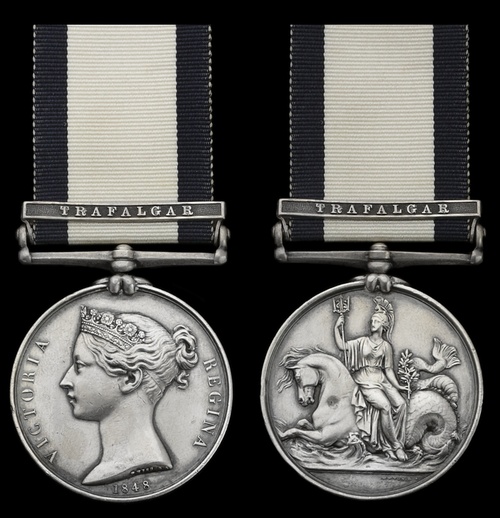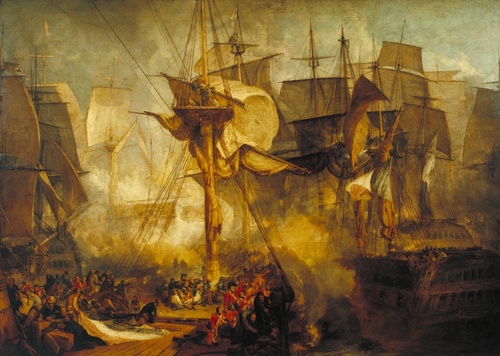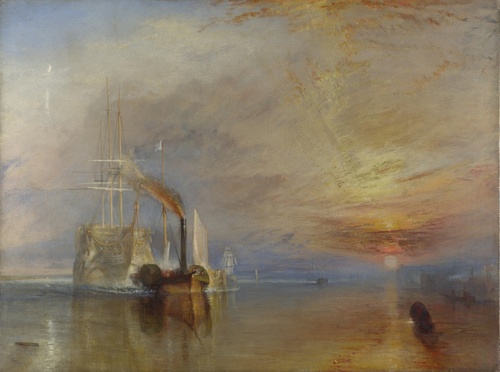Auction: 22003 - Orders, Decorations and Medals
Lot: 2
(x) The superb Naval General Service Medal awarded to Ordinary Seaman P. Cherry, Royal Navy, who was aboard the famous "Fighting Temeraire" at Trafalgar, whose ship played one of the most significant parts in that famous battle and later went on to find everlasting fame as the subject of one of artist J. M. W. Turner's most memorable and evocative paintings
Naval General Service 1793-1840, 1 clasp, Trafalgar (Peter Cherry.), good very fine
Peter Cherry, a unique name on the published Medal Roll, was born in Calais in 1783 and volunteered for the Royal Navy in September 1804: he served as an Ordinary Seaman aboard the 98-gun H.M.S. Temeraire at the Battle of Trafalgar - arguably she was to then become one of the most famous vessels in the history of the Royal Navy.
Opening Moves
On 21 October 1805 Temeraire, commanded by Captain Eliab Harvey, was second in Admiral Horatio Nelson's own Weather Column: the original plan had been for Harvey and Temeraire to lead the advance, but on the day Nelson in H.M.S. Victory assumed pole position. This led to a personal exchange between the great admiral and Harvey: after initially signalling for Temeraire to pass Victory, as they drew level the former called to the latter: "I'll thank you, Captain Harvey, to keep your proper station, which is astern of Victory!" A formal signal followed and Harvey reluctantly slowed Temeraire to allow Nelson's flagship to resume her prominent place in the attack on the Franco-Spanish line.
Battle Commences
Following close at the heels of Victory, Harvey in Temeraire crossed the bows of the 86-gun French flagship Bucentaure, giving her a broadside before making for the Spanish Santisima Trinidad, a behemoth 140-gun four-decker and the largest ship in the world at that time. Undaunted, Temeraire engaged this Spanish vessel for twenty minutes whilst also taking fire from the French Neptune and Redoutable. Sheering off from Santisima Trinidad, the two French ships were quickly developing into deadly foes: a broadside from Redoutable and another from Neptune brought down Temeraire's mizzen topmast, fore-yard and main topmast respectively. The fight was becoming a desperate affair, and was to become more desperate still.
Temeraire saves Victory
The expertly-fought Redoutable had now ranged up alongside Nelson's own Victory, sweeping her decks with musket fire and primitive grenades and her commander, Captain Lucas, had amassed a large party of men ready to board the British flagship. It was around this point that Admiral Nelson was hit by that fatal musket ball, leading to his death in the moment of victory. Meanwhile Harvey, realising despite the chaos of battle what was happening, brought Temeraire round and with perfect timing raked Redoutable from stern to stem with a double-shotted broadside. The resulting slaughter was horrendous, as Lucas (who miraculously survived the battle) later stated:
'...the three-decker [Temeraire] – who had doubtless perceived that the Victory had ceased fire and would inevitably be taken – ran foul of the Redoutable to starboard and overwhelmed us with the point-blank fire of all her guns. It would be impossible to describe the horrible carnage produced by the murderous broadside of this ship. More than two hundred of our brave lads were killed or wounded by it.'
However, the danger to Victory wasn't over yet; next Temeraire rammed Redoutable, dismounting a number of the Frenchman's guns with Harvey's crew then lashing the two ships together before commencing to pound the Redoutable with broadside after broadside of deadly fire at point-blank range. The Franco-Spanish ships were still giving as good as they got, with the Santa Ana and Fougueux then ranging up on Temeraire's un-engaged starboard side. The 74-gun Fougueux got too close to the British ship (possibly believing her to be too damaged to put up much more resistance) and Harvey, as ever in the thick of the fighting, ordered his men to hold their fire until 100 yards' range, when Temeraire unleashed yet another deadly broadside. This caused Fougueux to become temporarily out of control, and she lurched into Temeraire's side - where Harvey's men lashed her, too, to the valiant British vessel.
Crisis Point
Harvey and Temeraire were now sandwiched between two French 74's and therefore surrounded on all sides - after the battle Harvey wrote to his wife: "Perhaps never was a ship so circumstanced as mine, to have for more than three hours two of the enemy's line of battle ships lashed to her." He was in a perilous situation, which became more perilous still when men from the upper yards and fighting tops of Redoutable started lobbing grenades down onto Temeraire's upper deck: some of these caused small fires (deadly for a wooden ship) and one came dangerously close to igniting the after-magazine, which would have caused a terrible explosion and resulted in the destruction of Temeraire and those vessels around her. Happily however, the quick-thinking Master-at-Arms doused the flames just in time.
Final Moves
After twenty minutes of fighting two three-deckers, Redoutable surrendered and Captain Lucas called out for quarter; Harvey sent men across from Temeraire to take possession of his prize - Cherry is noted as being one of that party ordered to take over the French vessel which had caused so much destruction. Her battle was not yet over, however, as Fougueux was still fighting and Harvey assembled a boarding party to capture the French ship; with the cry of "Boarders Away!" the British, under First Lieutenant Kennedy, entered through the Fougueux's main-deck ports and steadily drove their enemy back - Commander Bazin, of the French vessel, surrendered shortly afterwards.
Harvey and his men had now defeated and captured two French ships of the line and had saved Victory from capture, but at terrible cost to themselves: 47 members of the ship's company had been killed and 76 wounded, all her sails, yards, and upper masts had been destroyed, and there was a gaping hole of no less than eight feet in her starboard hull. Realising they were in no fit state to continue fighting, Havey signalled the frigate H.M.S. Sirius to tow Temeraire out of the line to effect repairs - but a close shave occurred when the battered battleship was nearly attacked by a number of fresh Franco-Spanish ships. However, fresh British vessels came up just in time to save her from a difficult situation. Harvey, and the men of Temeraire, had truly done their bit.
Conclusion and Immortality
In the great storm which followed the battle, unfortunately both Temeraire's prizes foundered and sank in the heavy waves: 47 of her men, serving as prize crews, were also lost at this time but thankfully Cherry was amongst those saved. Riding out the storm, Harvey then made a personal report to Admiral Collingwood (the only captain to do so before Collingwood's victory despatch was written) which resulted in Temeraire being the only British ship mentioned by name for her heroic conduct.
Being so mentioned, Harvey and his ship became tremendously famous upon their return to Britain - not just with the general public, but with the upper echelons of society too: when the House of Commons passed a vote of thanks to the men who fought on that bloody day, only Nelson, Collingwood and - significantly - Harvey were mentioned by name. Artists too, keen to take advantage of this great victory, got involved - not just the well-known naval artist Nicholas Pocock, but none other than J.M.W. Turner. Temeraire's career came to an end in August 1838, when she was sold by the Admiralty and taken to Rotherhithe for breaking-up. It was during her journey up the Thames that Turner created his painting "The Fighting Temeraire tugged to her last Berth to be broken up, 1838" - an enormously evocative image of the transition between sail and steam which has subsequently been voted Britain's favourite painting (2005) and now graces, along with a portrait of Turner, the reverse of the current £20-note. Her lasting legacy is certainly an honourable one for Captain Harvey and the men of H.M.S. Temeraire - not forgetting, of course, Ordinary Seaman Peter Cherry. Post-Trafalgar, Cherry went on to serve aboard H.M.S. Canada (1805-1808) and H.M.S. St. Albans (1808-1810); in November 1848 he was admitted to Greenwich Hospital and died there, aged 74, on 15 July 1857.
For further reading, please see:
https://www.1805club.org/research-database/q/cherry/area/men-at-trafalgar
https://www.nationalarchives.gov.uk/trafalgarancestors/details.asp?id=15482
Subject to 5% tax on Hammer Price in addition to 20% VAT on Buyer’s Premium.
Sold for
£8,500
Starting price
£5200









